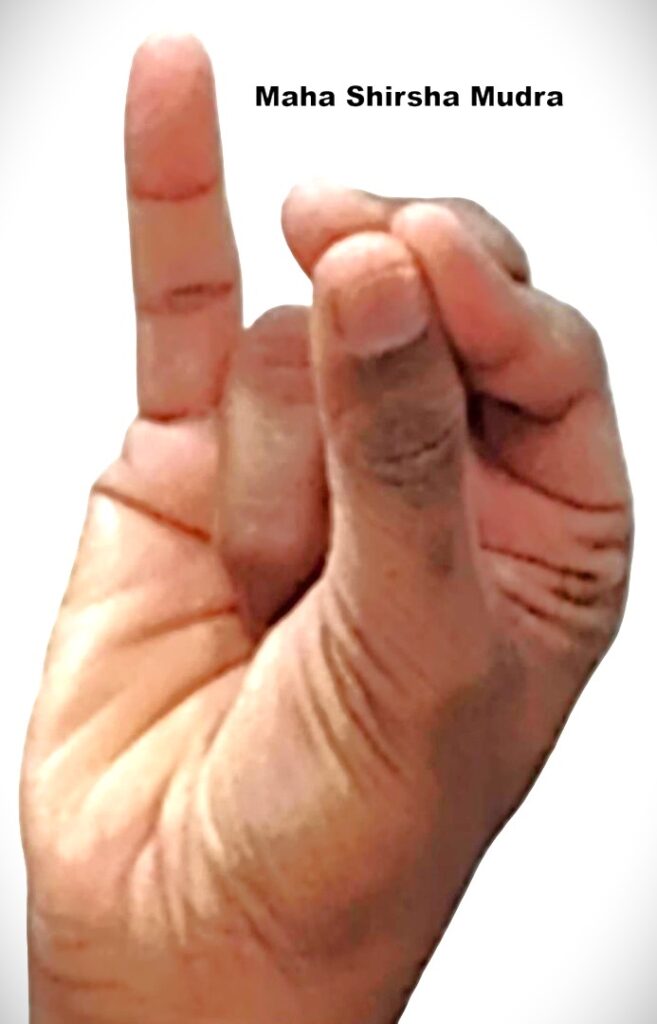Maha Shirsha Mudra
Introduction
Maha Shirsha Mudra is known as the “Great Head Gesture” in yogic and therapeutic traditions. It is primarily practiced to alleviate headaches, sinus issues, stress, and mental tension. The mudra works by balancing energy flow in the head region, improving circulation, and reducing blockages in the sinus and cranial areas.
It is widely recommended in mudra therapy for migraine, sinusitis, and anxiety-related head pressure.
Meaning
Maha = Great
Shirsha = Head
Mudra = Gesture, seal
Thus, Maha Shirsha Mudra means the great mudra for the head, symbolizing the regulation of pranic energy in the cranial and sinus regions.
How to Perform (Practice)
Sit in a comfortable posture (Sukhasana, Vajrasana, or a chair with straight back).
Relax shoulders and keep spine erect.
Hand Formation:
Join the tips of the thumb, index finger, and middle finger.
Fold the ring finger and little finger gently into the palm.
Press them lightly with the thumb (while still touching index and middle).
Place hands on thighs or knees with palms facing upward.
Close eyes, breathe deeply and slowly.
Focus awareness on the forehead, temples, and nasal passages.
Continue for 10–15 minutes or until relief is felt.
Benefits
Physical Benefits
Relieves headaches, migraines, and sinus pain.
Reduces tension in forehead, temples, and eyes.
Improves nasal airflow, beneficial in sinusitis.
Reduces fatigue and heaviness in the head.
Helpful in stress-related high blood pressure.
Energetic Benefits
Balances Prana Vayu (upward-moving energy in the head).
Clears blockages in Ajna Chakra (third-eye center).
Improves flow of prana in cranial nadis (energy channels).
Mental & Emotional Benefits
Reduces stress, anxiety, and overthinking.
Induces calmness and mental clarity.
Enhances focus and reduces irritability caused by headaches.
Contraindications
Not advised during very low blood pressure (can increase dizziness).
Avoid during severe dehydration or fainting conditions.
Should not replace medical treatment for chronic migraine or sinus infections—works as supportive therapy.
Anatomy & Physiology
Stimulates sinus cavities and improves drainage.
Relaxes cranial muscles and blood vessels, reducing migraine tension.
Enhances oxygen intake by opening nasal passages.
Reduces sympathetic overactivity, calming the nervous system.
Kinesiology
Thumb = Fire (energy, metabolism).
Index finger = Air (movement, nervous impulses).
Middle finger = Ether (space, expansion).
Folding of ring and little fingers reduces Earth and Water dominance.
This configuration reduces excess mucus, congestion, and pressure in the head region.
Neurology
Stimulates trigeminal nerve pathways, reducing facial pain and tension.
Calms autonomic nervous system activity → relieves stress-induced headaches.
Enhances neurovascular balance in cranial circulation.
Supports regulation of hypothalamic stress responses.
Duration of Practice
10–15 minutes, 2–3 times daily.
During acute headaches, can be practiced until relief is felt.
Regular practice helps prevent chronic sinus or tension headaches.
Counter Mudra
Prithvi Mudra → for grounding after excessive cranial energy activation.
Chin Mudra → for meditation and relaxation.
Shunya Mudra → to relieve ear-related and head pressure.
Conclusion
Maha Shirsha Mudra is an effective therapeutic gesture for head-related ailments, particularly headaches, migraines, and sinus congestion. By balancing the cranial energy and improving circulation, it provides natural relief from tension and stress. When practiced regularly, it enhances mental clarity, reduces pressure in the head, and restores pranic harmony.
FAQ
Q1. Can this mudra completely cure migraines?
It helps reduce frequency and intensity but should be practiced alongside lifestyle changes and medical advice.
Q2. When is the best time to practice?
Whenever headaches or sinus pressure arises; also preventive when done morning and evening.
Q3. Can children practice this mudra?
Yes, it is safe for children suffering from sinus congestion or headaches.
Q4. Does it work instantly?
In many cases, relief can be felt within 10 minutes, but chronic issues need consistent practice.
Q5. Can it be combined with Pranayama?
Yes, combining with Bhramari (humming bee breath) enhances its effectiveness for headaches.
References
Hirschi, Gertrud – Mudras: Yoga in Your Hands.
Satyananda Saraswati – Asana, Pranayama, Mudra, Bandha.
K. S. Joshi – Yoga and Mudras.
Research articles on mudras for headache and sinus management.
Ayurvedic & Yogic texts on Prana Vayu and cranial health.

